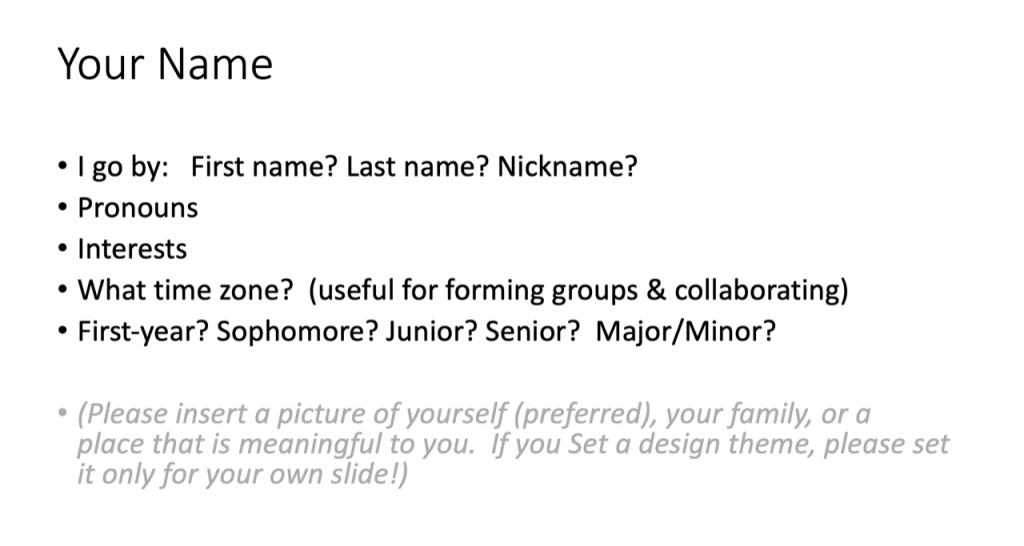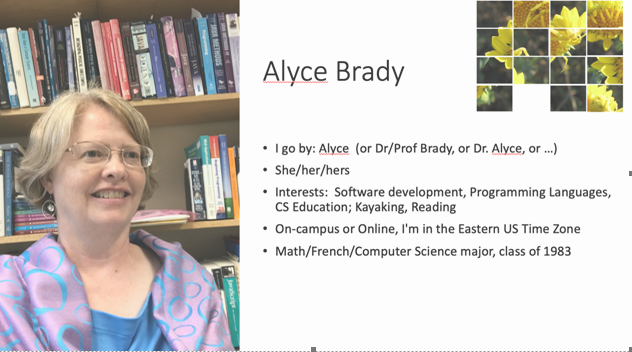
While the phrase “discussion leadership” typically brings to mind the work one does to facilitate a conversation in real-time, the shift to virtual learning due to COVID-19 invited two elephants into my Zoom room:
- The grim likelihood that our students would be facing a lot more disruption to their ability to attend class regularly, and
- the fact that, absent the bodily cues of in-person conversation, nurturing–and then following–a conversation on Zoom is hard.
(Of course, from an accessibility perspective, these elephants have always been in the room, even when that room was brick and mortar.)
The Discussion Leadership assignment I developed for my discussion-based course (a 100-level English class with 26 students) sought to address these challenges by carefully structuring our in-class time with asynchronous work, and by leaving behind a structure that could be accessed asynchronously for anyone who had not been able to attend class.
Here’s how it worked.
Each student was responsible for taking on a Discussion Leadership role for 4 classes throughout the quarter. There were 3 roles to choose from:
- Pre-Discussion: Develop 2-3 questions about the text that will guide our class discussion.
- Post-Discussion: Identify 1-2 key takeaways from our class discussion. Pose a new question that’s arisen for you, or that you feel we didn’t have time to address in full.
- Class Notes: Take detailed, structured notes on our class discussion.
My students posted their Discussion Leadership contributions to that week’s Forum on Moodle, so everyone would be able to locate and reference them.
Here’s an example of the worksheet I used to introduce the assignment and the aims of each role.
(Student signed up for roles at signup.com. The roles were intentionally doubled-up and there were significantly more slots than required, to allow for maximum flexibility and to increase the likelihood that, at minimum, Class Notes would be covered even if someone forgot, or ended up unexpectedly absent.)
How did we use these contributions?
I typically chose a couple of the pre-discussion questions to structure our class discussions (usually in small groups, where each group would choose a question to focus on). My students were able to exercise ownership of our discussions by highlighting elements they wished to discuss; and if needed, I could still add questions of my own to balance theirs.
The post-discussion syntheses were useful in offering a form of “endcap” to our discussions, which felt particularly important in virtual space, where discussions typically took a little longer and we were often running right up against the end of the period. Sometimes, I’d use the post-discussions to prompt a quickwrite at the start of the next class period, to return us to the thoughts we’d left off on the previous day. And honestly, I think being able to say “[Dilly Bar] posed a really great question I’d like to open with today” helped these quickwrites feel like genuine invitations to muse, rather than instructor-written prompts that secretly had right answers. In small ways, they reinforced our ideal classroom dynamic, where ideally students would talk to each other, rather than respond to me.
These posts also helped paint a picture of what class was like on any given day a student might have missed, and to offer them an opportunity to still engage asynchronously. That being said, Discussion Leadership was not intended as a fully asynchronous course option: The expectation of the class was that you would attend the synchronous meetings as often as possible. When it was not possible, however, it was intended to help make up the difference.
Students who were absent on any given day had the option of making up their class presence by reading the Class Notes and other Discussion Leadership, responding to questions that arose and offering their own interpretations/comments. While not the same as being able to participate in the synchronous session, it offered a safety net, and an invitation to continue engaging with the course materials/conversation for that day, even if Plan A didn’t pan out.
Maybe this all sounds workmanlike! It’s definitely not flashy. But sometimes simple, strong foundations are the best new gizmo when we and our students are sitting in our houses on fire, muttering “this is fine” to ourselves.
What did my students get out of it?
My students seemed to appreciate the Discussion Leadership because it wasn’t particularly difficult or time-consuming. As one student pointed out in an anonymous midterm reflection, in an ideal word it’d be stuff they should probably be doing all the time. (Ah, but ours is not an ideal world, is it?) One student noted that choosing to think up pre-discussion questions helped remind them that preparing for class wasn’t just about doing the reading, but engaging with the reading and thinking about what they wanted to say before logging into class. Note-takers would occasionally ask their classmates to repeat a comment to clarify their meaning, actively working to ensure their own comprehension/the accuracy of their record.
What I most valued about Discussion Leadership, outside of its utilitarian purpose, was the fact that the work was shared, low-stakes, and collaborative: Students didn’t need to stretch themselves to distraction, attempting to take notes while also contributing and listening to others as they made eye contact with their classmates’ Black Zoom Boxes, etc. because they knew they could rely on each other’s work, sit with each other’s insights, or compare their own takeaways from a class with the written record of another. Discussion Leadership helped make our virtual interactions more tangible. It served a written record of our collective knowledge-building, and allowed us to see how far we’d come, even as days blurred and time seemed to corkscrew.
Not a bad day’s work for a Moodle forum!


